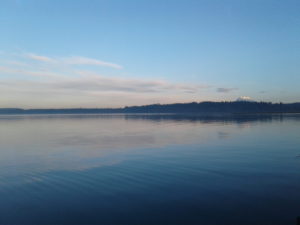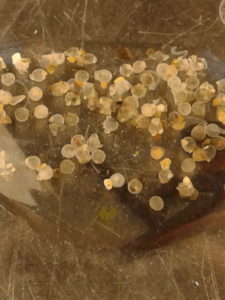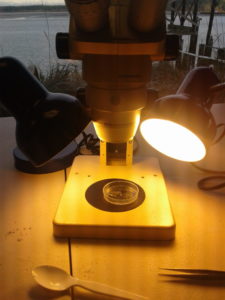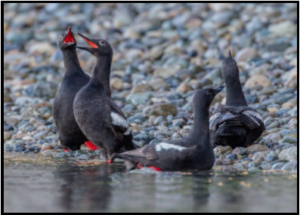Hidden Gems of the Puget Sound: Green ’20 at the Nisqually Reach Nature Center
Mar 11, 2018I have spent this winter in Olympia, WA, working with the Nisqually Reach Nature Center (NRNC) as a research intern. NRNC is a small non-profit organization based on the coast of the Nisqually Estuary, the meeting point of the Nisqually Delta and the South Puget Sound. For over 30 years, NRNC has worked closely with the Washington Department of Natural Resources and the Department of Fish and Wildlife to engage in research and provide education to the public for the betterment of the Puget Sound ecosystem. During my time at NRNC, I have assisted with their longitudinal research projects on forage fish and pigeon guillemots.

This was the view from my work space at the nature center. That’s Rainier in the background!
I’ve spent most of my time working on the forage fish research project. The term “forage fish” refers to any species of small fish which live in schools. The eggs of these fish wash up to shores during high tides. Because of the vital role they play in the food web of the Puget Sound ecosystem, forage fish are studied as indicator species, meaning their health as a species indicates the health of the entire ecosystem. At the nature center, we particularly research sand lance and surf smelt eggs. I have participated in pretty much every part of the research process which consists of: taking sand samples at the most recent high tide mark, sieving and vortexing the samples to remove large and heavy materials , analyzing samples for eggs using a microscope, and then determining the developmental stage of the eggs. Most of the eggs we find come from surf smelt while only a few samples contain sand lance. I knew from previous classes that I had an interest in aquatic biology, and participating in this project has furthered that interest.



(Left) A collection of sand lance eggs I extracted from a sample. (Middle) My microscope set-up for sample analysis. (Right) A leather star we found on the beach of Anderson Island during a forage fish sampling trip.
The other project I help with is their pigeon guillemot surveys. Pigeon guillemots are small, black and white seabirds with bright red feet. These birds nest in small burrow holes in cliffsides next to the water. Although the project is most active in the summer breeding season, I have been involved in the project through assisting in statistical analysis and writing for the 2017 report.

Pigeon Guillemots in adult plumage (Photo by Jeff Schwilk).
I have adored my time in Olympia, and my time working with the Nisqually Reach Nature Center. Through this co-op, I have expanded my knowledge, skills, and confidence in ecological surveys and statistical methods. I am excited to continue learning everything I can from this organization for the rest of this co-op.
You can learn more about the Nisqually Reach Nature Center at their website: nisquallyestuary.org


